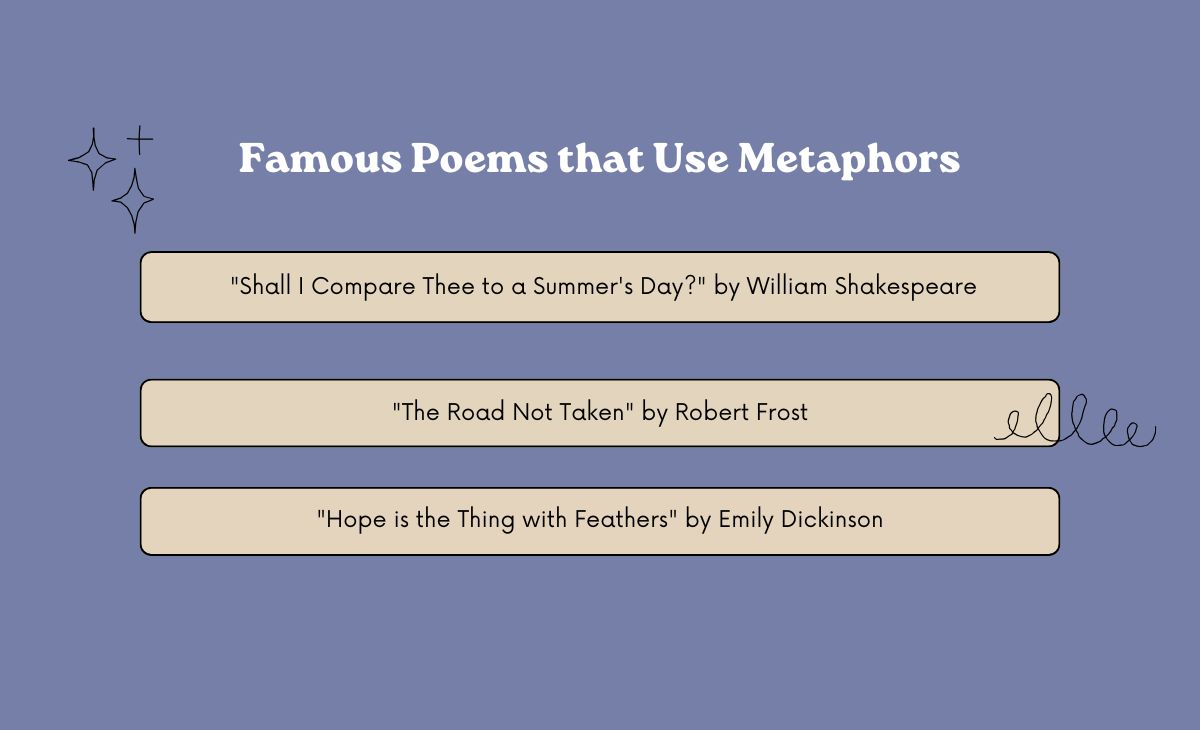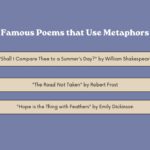Poetry has the remarkable ability to transform ordinary language into extraordinary meaning through the power of metaphors.
These literary devices allow poets to compare two seemingly unrelated things, creating deeper connections and emotional resonance that speaks directly to the human experience.
Famous poems that use metaphors have shaped literature for centuries, offering readers new ways to understand love, life, death, and everything in between.
1. “Shall I Compare Thee to a Summer’s Day?” by William Shakespeare
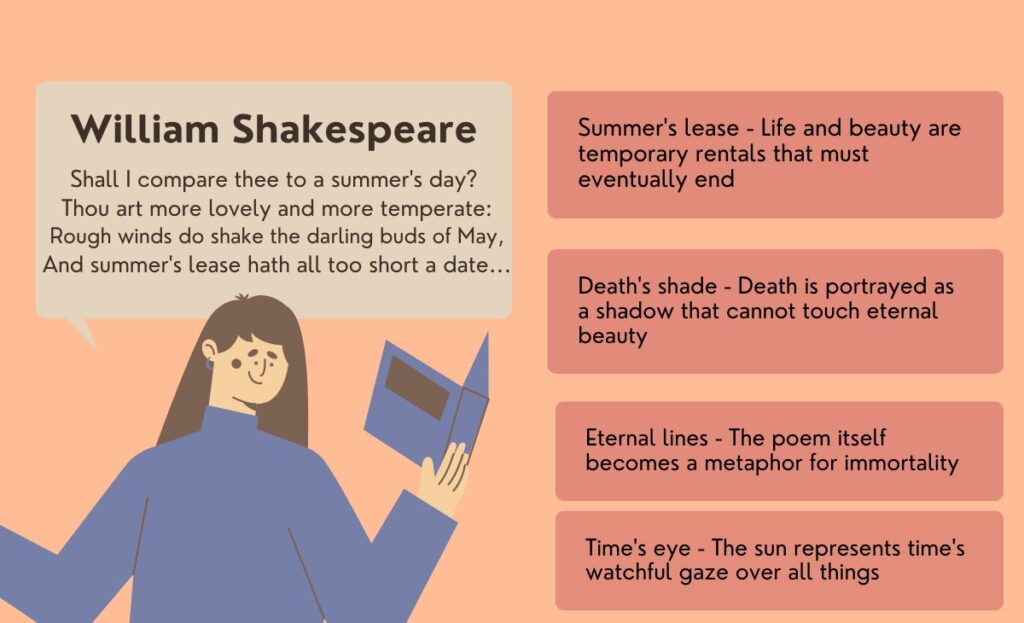
Shall I compare thee to a summer’s day?
Thou art more lovely and more temperate:
Rough winds do shake the darling buds of May,
And summer’s lease hath all too short a date…
This famous poem with metaphors presents one of literature’s most celebrated extended metaphors, comparing the beloved to a perfect summer day.
Key Metaphors:
- The beloved as summer’s day – Creates an image of warmth, beauty, and perfection
- Summer’s lease – Life and beauty are temporary rentals that must eventually end
- Death’s shade – Death is portrayed as a shadow that cannot touch eternal beauty
- Eternal lines – The poem itself becomes a metaphor for immortality
- Time’s eye – The sun represents time’s watchful gaze over all things
2. “The Road Not Taken” by Robert Frost
Two roads diverged in a yellow wood,
And sorry I could not travel both
And be one traveler, long I stood
And looked down one as far as I could…
Frost’s masterpiece uses the metaphor of diverging paths to explore life’s choices and their consequences, making it one of the most famous metaphorical poems in American literature.
Key Metaphors:
- Diverging roads – Life choices and different paths we can take
- Yellow wood – The autumn of life when important decisions must be made
- Undergrowth – Unknown consequences and hidden challenges ahead
- Grassy and wanting wear – Untrodden opportunities that call to us
- Ages and ages hence – The distant future when we reflect on our choices
3. “Hope is the Thing with Feathers” by Emily Dickinson
“Hope” is the thing with feathers –
That perches in the soul –
And sings the tune without the words –
And never stops – at all –
Dickinson transforms the abstract concept of hope into a tangible bird metaphor, creating one of the most beloved poems with metaphors about resilience and faith.
Key Metaphors:
- Hope as a bird – Makes the intangible emotion visible and relatable
- Perches in the soul – Hope finds a permanent home within us
- Sings without words – Hope communicates beyond language
- Sweetest in the gale – Hope grows stronger during difficult times
- Never asks for crumbs – Hope requires nothing in return for its gifts
4. “Do Not Go Gentle Into That Good Night” by Dylan Thomas
Do not go gentle into that good night,
Old age should burn and rave at close of day;
Rage, rage against the dying of the light.
Though wise men at their end know dark is right…
Thomas creates powerful metaphors for death and resistance, making this one of the most emotionally charged famous poems that use metaphors about mortality.
Key Metaphors:
- Good night – Death as peaceful sleep rather than violent end
- Dying of the light – Life’s end compared to sunset or dimming flame
- Close of day – Old age as evening time
- Burn and rave – Passionate resistance as fire against darkness
- Forked lightning – Brief but brilliant moments of human insight
5. “I Wandered Lonely as a Cloud” by William Wordsworth
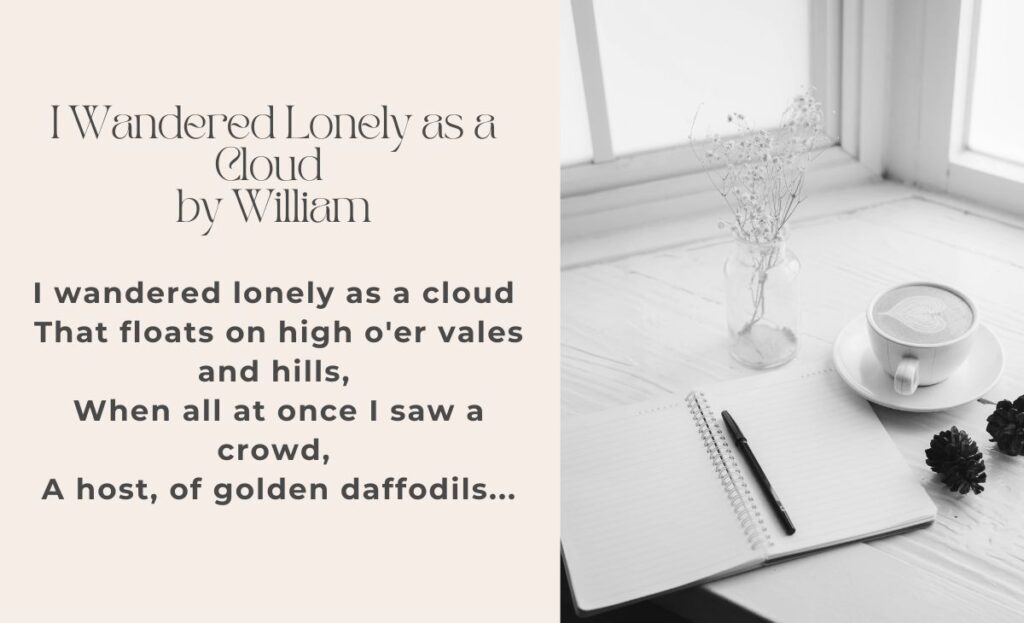
I wandered lonely as a cloud
That floats on high o’er vales and hills,
When all at once I saw a crowd,
A host, of golden daffodils…
Wordsworth’s metaphorical poem captures the transformative power of nature through vivid comparisons that have made it one of the most famous metaphor examples in Romantic poetry.
Key Metaphors:
- Lonely as a cloud – Isolation and detachment from earthly concerns
- Host of daffodils – Flowers as welcoming crowd or army of joy
- Dancing in the breeze – Nature’s celebration and liveliness
- Wealth the show brought – Natural beauty as spiritual treasure
- Inward eye – Memory and imagination as inner vision
More Post: 19 Inspiring Black History Poems for Church Services and Celebrations
6. “Chicago” by Carl Sandburg
Hog Butcher for the World,
Tool Maker, Stacker of Wheat,
Player with Railroads and the Nation’s Freight Handler;
Stormy, husky, brawling…
Sandburg personifies Chicago through powerful industrial metaphors, creating one of the most vivid poems with metaphors about American urban life.
Key Metaphors:
- Hog Butcher – City as provider of sustenance to the world
- Tool Maker – Chicago as creator and builder of civilization
- Player with Railroads – City as master of transportation and commerce
- Painted women – Urban corruption and moral complexity
- Big shoulders – Strength and ability to bear heavy burdens
7. “Mirror” by Sylvia Plath
I am silver and exact. I have no preconceptions.
Whatever I see I swallow immediately
Just as it is, unmisted by love or dislike.
I am not cruel, only truthful…
Plath gives voice to a mirror in this metaphorical poem, exploring themes of aging, self-perception, and truth through one of the most unique famous poems that use metaphors.
Key Metaphors:
- Mirror as honest observer – Unbiased witness to human change
- Swallow immediately – Mirror consumes and reflects reality
- Eye of a little god – Mirror as divine judge of appearance
- Terrible fish – Aging woman rising from depths of self-reflection
- Lake – Mirror’s surface as deep water of contemplation
8. “Dreams” by Langston Hughes
Hold fast to dreams
For if dreams die
Life is a broken-winged bird
That cannot fly.
Hughes uses bird and field metaphors in this concise yet powerful poem with metaphors about the importance of maintaining hope and ambition.
Key Metaphors:
- Dreams as birds – Aspirations that can soar or be grounded
- Broken-winged bird – Life without purpose or hope for flight
- Barren field – Existence without growth or possibility
- Frozen with snow – Dreams killed by harsh circumstances
- Hold fast – Dreams require active protection and care
9. “Phenomenal Woman” by Maya Angelou
Pretty women wonder where my secret lies.
I’m not cute or built to suit a fashion model’s size
But when I start to tell them,
They think I’m telling lies.
Angelou celebrates feminine power through body metaphors and confident imagery, making this one of the most empowering famous metaphorical poems about self-acceptance.
Key Metaphors:
- Secret ingredient – Inner confidence as mysterious power
- Fire in my eyes – Passion and strength burning within
- Joy in my feet – Happiness expressed through movement
- Grace of my style – Natural elegance that cannot be taught
- Phenomenal woman – Extraordinary nature beyond conventional beauty
More Post: 35 Heartfelt Love Poems for Him That Will Make Your Boyfriend Cry with Joy
10. “A Red, Red Rose” by Robert Burns
O my Luve is like a red, red rose
That’s newly sprung in June;
O my Luve is like the melody
That’s sweetly played in tune.
Burns creates one of literature’s most famous metaphor examples for love, comparing his beloved to nature’s most beautiful offerings in this classic metaphorical poem.
Key Metaphors:
- Red rose – Love as beautiful, fragrant, but potentially thorny
- Newly sprung in June – Fresh, perfect love at its peak season
- Sweet melody – Love as harmonious music that pleases the soul
- Seas gang dry – Impossible circumstances that test eternal love
- Rocks melt wi’ the sun – Natural laws that would have to change
11. “The Guest House” by Rumi
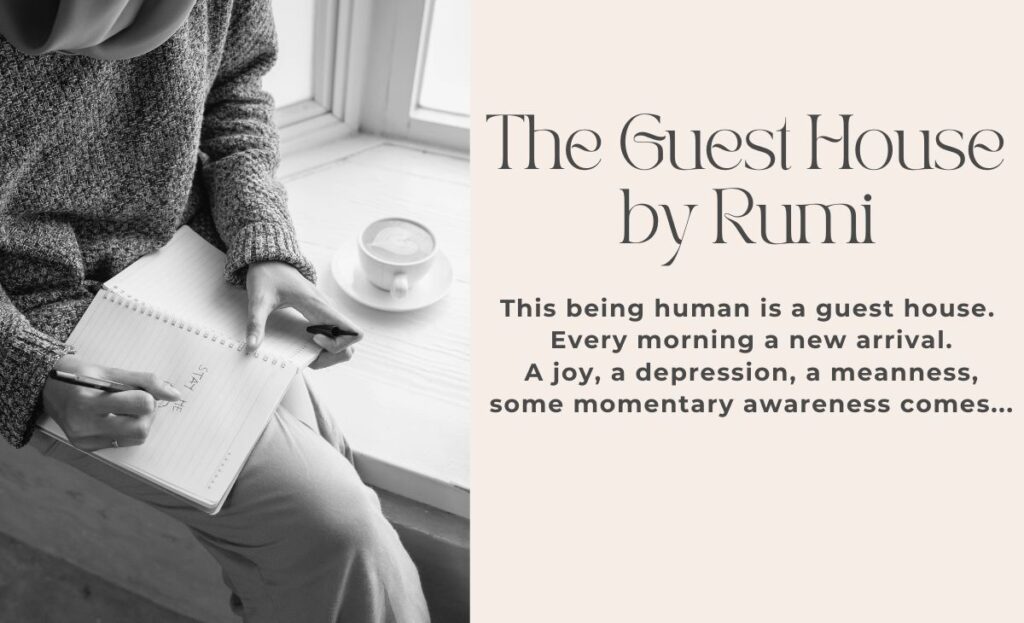
This being human is a guest house.
Every morning a new arrival.
A joy, a depression, a meanness,
some momentary awareness comes…
Rumi transforms human experience into a hospitality metaphor, creating one of the most profound poems with metaphors about accepting all aspects of life.
Key Metaphors:
- Human as guest house – Our consciousness as temporary accommodation
- Emotions as visitors – Feelings that come and go like guests
- Dark thought as guide – Negative experiences as teachers
- Clearing out – Making space for new emotional experiences
- Meet them at the door laughing – Welcoming all feelings with joy
12. “Tonight I Can Write the Saddest Lines” by Pablo Neruda
Tonight I can write the saddest lines.
Write, for example, ‘The night is starry
and the stars are blue and shiver in the distance.’
The night wind revolves in the sky and sings.
Neruda weaves nature metaphors throughout this heartbreaking famous poem that uses metaphors to explore love, loss, and the power of memory.
Key Metaphors:
- Starry night – Vast loneliness reflecting inner emotional state
- Shivering stars – Celestial bodies sharing the poet’s pain
- Night wind singing – Nature echoing the poet’s sorrowful song
- Soul not satisfied – Love as hunger that remains unfulfilled
- Writing the saddest lines – Poetry as outlet for overwhelming grief
Conclusion
These famous poems that use metaphors demonstrate the incredible power of figurative language to transform simple words into profound experiences. From Shakespeare’s eternal summer to Angelou’s phenomenal woman, each metaphorical poem offers readers a unique lens through which to view universal human experiences.
These masterpieces prove that poetry metaphors don’t just decorate language—they illuminate truth, evoke emotion, and create lasting connections between poet and reader.

I’m Chloe Eden, the heart behind ReverbLove.com. I Share Soulful Poems that touch Emotions, Inspire Hearts, and Celebrate Love. Words are My Art, and Poetry is My Passion.
